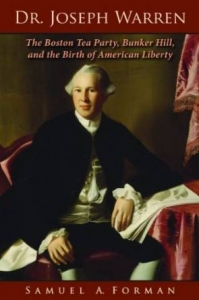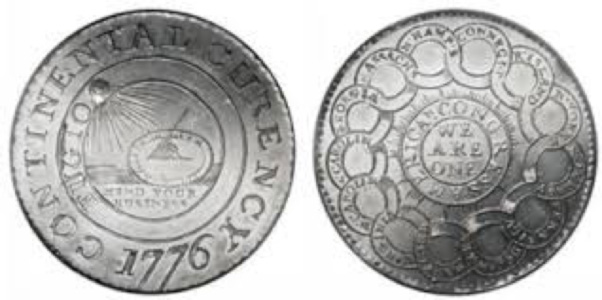Coins in Revolutionary America
Blog submission by Sam Forman to Lora Innes’ The Dreamer
PART 3:

Bea, memorize this table if you really want to impress your merchant dad, uncle Hercules, and other business minded folks you encounter. It is from the New York Pocket Almanac for 1771.
A challenge to the fledgling Continental government was to make sense of the different kinds of money in circulation. An even bigger challenge was that there was not enough of any kind of it. How could the Continental Army buy weapons and gunpowder, feed and clothe its soldiers, and pay them? A strategy, expanded from earlier colonial beginnings, was to float bonds and paper money at the Continental and state levels. There came to be a whole lot of printing of paper money going on until it was “not worth a Continental” by the end of the Revolutionary War.
In 1776, the Continental and provincial paper money had not yet depreciated so dramatically. But with every military defeat and new issue of paper, it took more and more paper bills to equal the buying power of silver and gold coins. Wily British policy apparently was to encourage counterfeiting in order to further undermine confidence in the American cause and to sabotage their rebellious subjects’ ability to buy supplies.
An intriguing attempt at a Continental coinage appeared briefly in 1776. The Continental dollars were probably a test coinage appearing in pewter, bronze, and a few in silver. Controversy exists concerning the minter, whose initials E.G. could mean ‘eg fecit’ – I made it in Latin and/or Elisha Gallaudet, a New Jersey patriot engraver and printer. In any case, this coinage idea succumbed to the faltering American cause in the Fall of 1776.
Here are examples of the Continental dollar of 1776. So, how do you spell ‘Currency?’ One R or two? How about both ways? Bea, if you see a silver one of these in change in brand new 1776 condition, take it back with you to the twenty-first century. An example has sold for over a million dollars recently at auction. Maybe mom and dad will lighten up about that drug overdose and coma episode if you apologize humbly, buy your own prom dress, pay off their home mortgage, and put yourself through college with the proceeds.
Continental paper money inscriptions asserted they were exchangeable for gold and silver coins of the stated value. As the war wore on, this became wishful thinking. Continental and provincial paper money depreciated at variable market rates, leaving soldiers holding the bag, so to speak, of being paid in increasingly worthless currency. Silver and gold coins were harder and harder to come by.
The French poured in men and material, thereby tipping the balance to achieving American Independence. In 1782 John Adams floated a loan from Holland preventing outright bankruptcy of the Continental Congress. Just when you thought you had the swing of things with Spanish pillar dollars and pieces of eight, now we have to deal with Dutch Guilders and French gold Louis D’Ors!
Peacetime did not much improve monetary confusion. Ingredients of a weak, underfunded Confederation government and thirteen states all issuing their own money to different standards, made for quite a monetary stew. Foreign coins still circulated, still more reliable for higher value transactions in silver and gold.
American coinage attempts of the 1780s were colorful and interesting for their devices and symbolism, but did not constitute a foundation for an effective monetary system for the new country.
America was likened to a new constellation among the firmament of nations on this 1780s Nova Constellatio issue. The all-seeing eye made it to the back of our modern dollar bills, but not much else.
Massachusetts issued an appealing series of copper coins. I wonder if Paul Revere contributed some copper to these. Jack of all trades, he had etched the plates for Massachusetts’ paper money issues early during the Revolutionary War. No one thought to put the penny (pictured upper) and half penny (lower) denominations on the coins. They look the same to me.
A New York jeweler produced a handful of gold coins in 1787. These Brasher Doubloons are considered among the most valuable and interesting of all American coins. One sold for 7 million dollars at auction in recent years. The American eagle and shield of the United States make an early appearance here.
The solution to long standing chronic government money woes would be, according to Alexander Hamilton in the Washington administration of the 1790s, a strong federal government possessing the power to tax meaningfully, and to create a strong gold and silver-backed currency welcomed internationally. Along the way, the world’s first decimal coinage would ultimately banish odd denominations, bits, and the need for separate state monetary systems.
Perhaps Mr. Hamilton had in mind the beautiful Beatrice he had met years before, when encouraging a stunning allegorical Miss Liberty to appear front and center on the new nation’s coinage, from half penny through ten dollar gold coin denominations.

Miss Liberty appears on the first regular coinage issues of the United States of America under the Constitution.

 Sam Forman is the modern biographer of Dr. Joseph Warren (Pelican, 2012). The Continental Dollar makes a cameo appearance in his upcoming historical romance novel Twenty-One Heroes (Pelican, Fall 2015), where liberty is a seductive principle for young Revolutionary Americans.
Sam Forman is the modern biographer of Dr. Joseph Warren (Pelican, 2012). The Continental Dollar makes a cameo appearance in his upcoming historical romance novel Twenty-One Heroes (Pelican, Fall 2015), where liberty is a seductive principle for young Revolutionary Americans.





